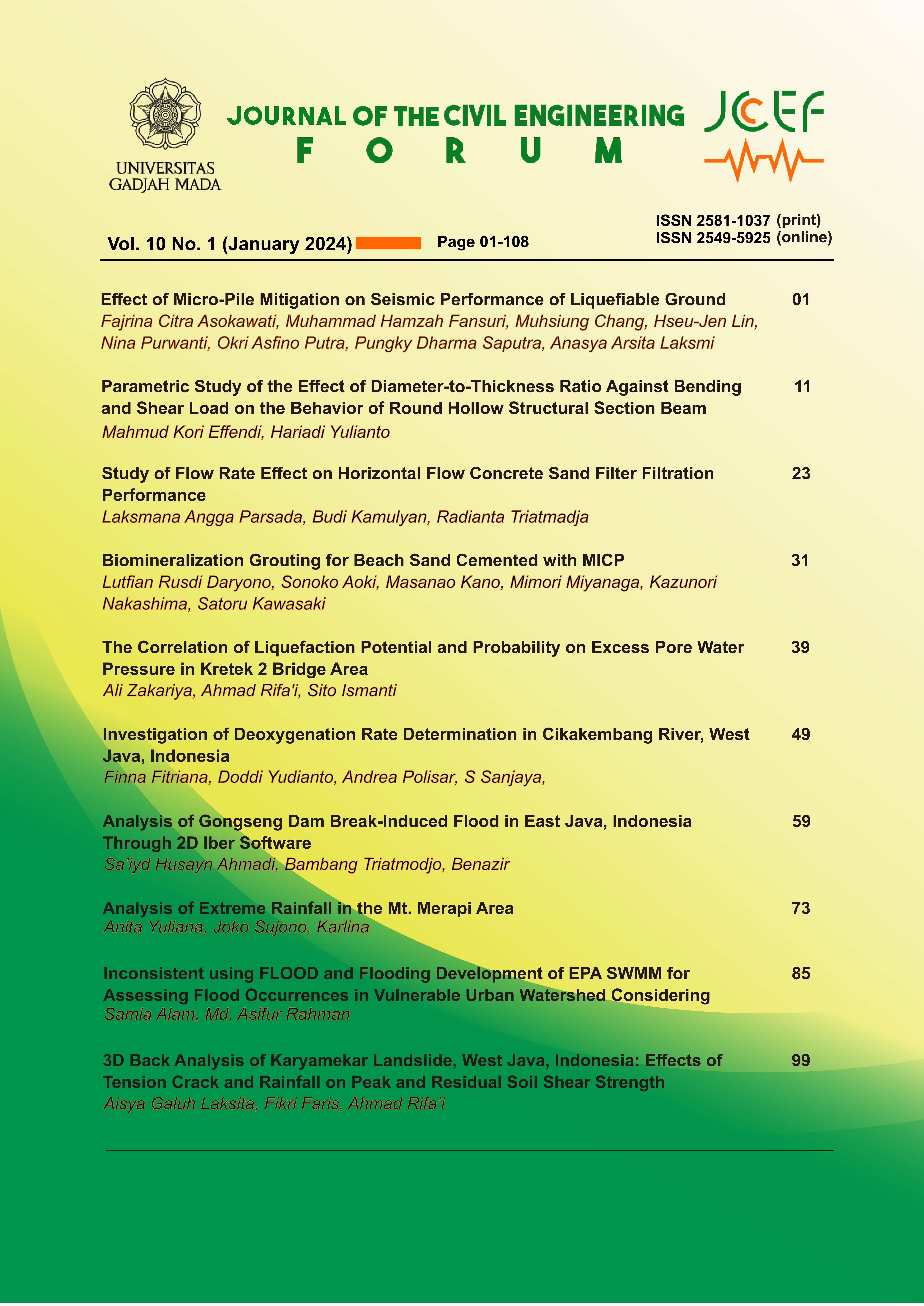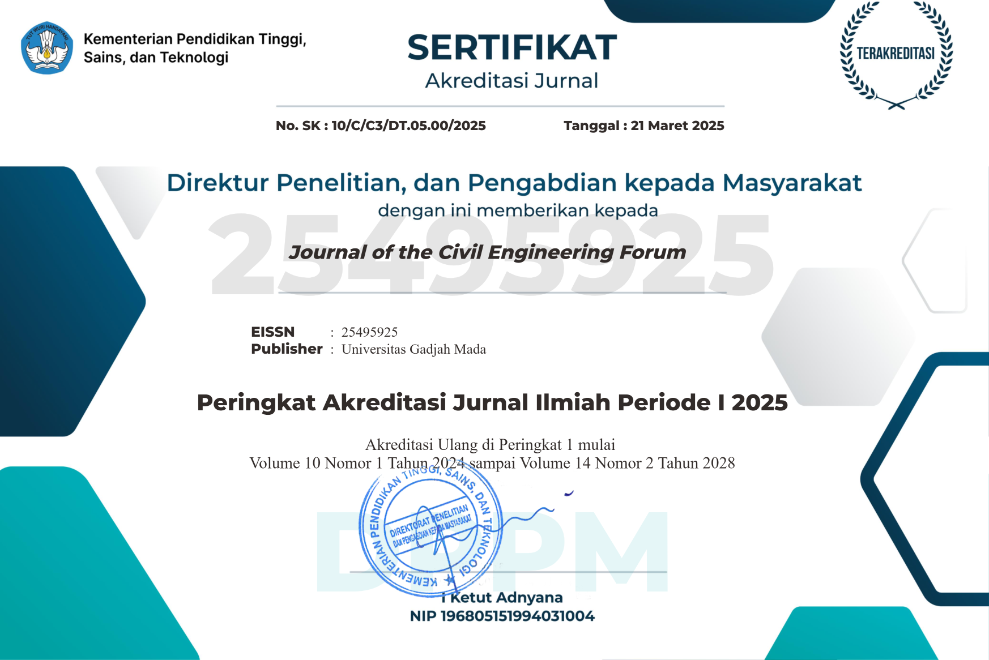Analysis of Extreme Rainfall in the Mt. Merapi Area
Abstract
The slopes of Mount Merapi (Mt. Merapi) are an area prone to hydrological disasters due to elevation and orography. Hydrological disasters that have the potential to occur include floods, erosion, landslides, and drought which are closely related to extreme rainfall. Spatial and temporal variability of rainfall in mountainous areas requires rainfall data that can represent rainfall events. Therefore, this research aims to obtain the reliability of satellite rainfall data in the extreme rainfall indices. The CHIRPS, GPM-IMERG FINAL (IMERG-F) and GPM-IMERG LATE (IMERG-L) will be used in the reliability analysis of satellite-based rainfall compared to observed rainfall station. To validate satellite rain data, statistical criteria are utilized with parameters such as Correlation Coefficient (R), Root Mean Squared Error (RMSE), and Relative Bias (RB). Satellite-based rainfall estimates have a weak to moderate correlation (0.19 – 0.55), the RMSE value is relatively good (12.18 – 31.35 mm) and the observed bias tends to underestimate the estimated values. The capabilities of the IMERG-F, IMERG-L and CHIRPS satellites as alternative rainfall data in the Mt. Merapi area are quite good where IMERG-L has the best performance in capturing rainfall above 50 mm (R50mm), Consecutive Dry Days (CDD) indices, max 1–day and 5-day precipitation (Rx1day and Rx5day). The potential for extreme rainfall that is most prone to trigger lava floods occurs in the western region of Mt. Merapi at Ngandong Station (Sta. Ngandong). In this region, there is a high occurrence of extreme rainfall events. For instance, there were 501 instances of R50mm with an intensity of 77 mm day-1, Total Precipitation (PRCPTOT) reaches 3385 mm, Rx5day reaches 393 mm, and Consecutive Wet Days (CWD) lasts for 30 days. The results of this analysis can assist in climate understanding and modeling of extreme rainfall relevant to the region and support water resource management and disaster risk mitigation.
References
Ayehu, G. T., Tadesse, T., Gessesse, B. and Dinku, T. (2018), ‘Validation of new satellite rainfall products over the Upper Blue Nile Basin, Ethiopia’, Atmospheric Measurement Techniques 11(4), 1921–1936. URL: https://doi.org/10.5194/amt-11-1921-2018
Baig, F., Abrar, M., Chen, H. and Sherif, M. (2022), ‘Rainfall consistency, variability, and concentration over the uae: Satellite precipitation products vs. rain gauge observations’, Remote Sensing 14(22), 1–26. URL: https://doi.org/10.3390/rs14225827
Farzana, S. Z., Zafor, M. A. and Shahariar, J. A. (2019), ‘Application of swat model for assessing water availability in Surma River basin’, Journal of the Civil Engineering Forum 5(1), 29. URL: https://doi.org/10.22146/jcef.39191
Filho, G. M. R., Hugo Rabelo Coelho, V., da Silva Freitas, E., Xuan, Y., Brocca, L. and das Neves Almeida, C. (2022), ‘Regional-scale evaluation of 14 satellite-based precipitation products in characterising extreme events and delineating rainfall thresholds for flood hazards’, Atmospheric Research 276(May), 106259. URL: https://doi.org/10.1016/j.atmosres.2022.106259
Gupta, H. V., Sorooshian, S. and Yapo, P. O. (1999), ‘Status of automatic calibration for hydrologic models: Comparison with multilevel expert calibration’, Journal of Hydrologic Engineering 4(2), 135–143. URL: https://doi.org/10.1061/(asce)10840699(1999)4:2(135)
Gustoro, D., Sujono, J. and Karlina (2022), ‘Perbandingan pola distribusi hujan terukur dan hujan satelit di DAS Progo’, Jurnal Teknik Pengairan: Journal of Water Resources Engineering 2022(1), 23–35. URL: https://doi.org/10.21776/ub.pengairan.2022.013.01.03
Hambali, R., Legono, D. and Jayadi, R. (2019), ‘Correcting radar rainfall estimates based on ground elevation function’, Journal of the Civil Engineering Forum 5(3), 300. URL: https://doi.org/10.22146/jcef.49395
Harto, S. (1993), Analisis hidrologi, Penerbit PT Gramedia Pustaka Utama.
Liu, S., Wang, J. and Wang, H. (2022), ‘Assessing 10 satellite precipitation products in capturing the july 2021 extreme heavy rain in Henan, China’, Journal of Meteorological Research 36(5), 798–808. URL: https://doi.org/10.1007/s13351-022-2053-y
Misnawati, M., Boer, R., June, T. and Faqih, A. (2018), ‘Perbandingan metodologi koreksi bias data curah hujan chirps’, Limnotek: perairan darat tropis di Indonesia 25(1).
Partiwi, E. P., Sujono, J. and Jayadi, R. (2012), ‘Kajian variabilitas curah hujan di kawasan lereng Gunung Merapi dengan uji mann-kendall’, 13(1), 28–38. URL: https://doi.org/10.36706/jhs.v13i1.17
Pratiwi, E. P. A., Ramadhani, E. L., Nurrochmad, F. and Legono, D. (2020), ‘The impacts of flood and drought on food security in central java’, Journal of the Civil Engineering Forum 6(1), 69. URL: https://doi.org/10.22146/jcef.51872
Prayuda, D. D. (2012), ‘Temporal and spatial analysis of extreme rainfall on the slope area of Mt. Merapi’, Civil Engineering Forum XXI, 1285–1290. URL: https://doi.org/10.22146/jcef.18922
Prayuda, D. D. (2015), ‘Analisis karakteristik intensitas hujan di wilayah lereng Gunung Merapi’, Jurnal Rekayasa Insfrastruktur 1, 14–19. URL: https://doi.org/10.30607/jri.v1i1.52
Putra, S. S., Ridwan, B. W., Yamanoi, K., Shimomura, M., Sulistiyani and Hadiyuwono, D. (2019), ‘Point-based rainfall intensity information system in Mt. Merapi area by x-band radar’, Journal of Disaster Research 14(1), 80–89. URL: https://doi.org/10.20965/JDR.2019.P0080
Rahmawati, N., Rahayu, K. and Yuliasari, S. T. (2021), ‘Performance of daily satellite-based rainfall in groundwater basin of merapi aquifer system, Yogyakarta’, Theoretical and Applied Climatology . URL: https://doi.org/10.1007/s00704-021-03731-9
Ramadhan, R., Muharsyah, R., Marzuki, Yusnaini, H., Vonnisa, M., Hashiguchi, H., Suryanto, W. and Sholihun (2022), ‘Evaluation of gpm imerg products for extreme precipitation over Indonesia’, Journal of Physics: Conference Series 2309(1).
URL: https://doi.org/10.1088/17426596/2309/1/012008
Rauniyar, S. P., Protat, A. and Kanamori, H. (2017), ‘Uncertainties in trmm-era multisatellite-based tropical rainfall estimates over the maritime continent’, Earth and Space Science 4(5), 275–302. URL: https://doi.org/10.1002/2017EA000279
Sandy Putra, S., Hassan, C. and Hariyadi, S. (2012), ‘Hot pyroclastic deposit as lahar resistor: A case study of gendol river after the Mt. Merapi 2010 eruption’, WIT Transactions on Engineering Sciences 73, 97–109. URL: https://doi.org/10.2495/DEB120091
Sapan, E. G. A., Sujono, J. and Karlina (2022), ‘Analisis karakteristik hujan ekstrim menggunakan model iklim di wilayah Gunung Merapi’, Media Komunikasi Teknik Sipil 28(1), 99–108. URL: https://doi.org/mkts.v28i1.36332
Sofia, D. A. (2017), ‘Analisis durasi hujan dominan dan pola distribusi curah hujan jam-jaman di wilayah Gunung Merapi’, Jurnal Teknologi Rekayasa 1(1), 7. URL: https://doi.org/10.31544/jtera.v1.i1.2016.714
Talchabhadel, R., Nakagawa, H., Kawaike, K., Yamanoi, K., Musumari, H., Adhikari, T. R. and Prajapati, R. (2021), ‘Appraising the potential of using satellite-based rainfall estimates for evaluating extreme precipitation: A case study of august 2014 event across the West Rapti River Basin, Nepal’, Earth and Space Science 8(8), 1–15. URL: https://doi.org/10.1029/2020EA001518
Tan, M. L. and Santo, H. (2018), ‘Comparison of gpm imerg, tmpa 3b42 and persiann-cdr satellite precipitation products over Malaysia’, Atmospheric Research 202(November 2017), 63–76. URL: https://doi.org/10.1016/j.atmosres.2017.11.006
Undang-undang Nomor 17 Tahun 2019 tentang Sumber Daya Air (2019).
Wiwoho, B. S., Astuti, I. S., Alfarizi, I. A. G. and Sucahyo, H. R. (2021), ‘Validation of three daily satellite rainfall products in a humid tropic watershed, brantas, indonesia: Implications to land characteristics and hydrological modelling’, Hydrology 8(4). URL: https://doi.org/10.3390/hydrology8040154
Yuono, T. and Mulyandari, E. (2021), ‘Kajian penggunaan data hujan satelit trmm untuk
perencanaan talang air irigasi pada Daerah Irigasi Ngarum’, Jurnal Teknik Sipil dan Arsitektur 26(1), 41–48. URL: https://doi.org/10.36728/jtsa.v26i1.1243
Zhang, C., Chen, X., Shao, H., Chen, S., Liu, T., Chen, C., Ding, Q. and Du, H. (2018), ‘Evaluation and intercomparison of high-resolution satellite precipitation estimates - gpm, trmm, and cmorph in the Tianshan Mountain Area’, Remote Sensing 10(10). URL: https://doi.org/10.3390/rs10101543
Copyright (c) 2024 The Author(s)

This work is licensed under a Creative Commons Attribution-ShareAlike 4.0 International License.
Copyright is granted to authors for the purpose of providing protection for articles written to describe experiments and their results. JCEF will protect and defend the work and reputation of the author and are also willing to address any allegations of violation, plagiarism, fraud, etc. against articles written and published by JCEF. JCEF is published under the terms of the Creative Commons Attribution-ShareAlike 4.0 International License (CC BY-SA 4.0). The author holds the copyright and assigns the journal rights to the first publication (online and print) of the work simultaneously.







